March 2008
Nicaragua
Carreterras Sinuosas, Puentes Angostas, y Pavimento en Mal Estata
All that means windy roads, narrow bridges, and pavement in bad condition – aka welcome to Central America!
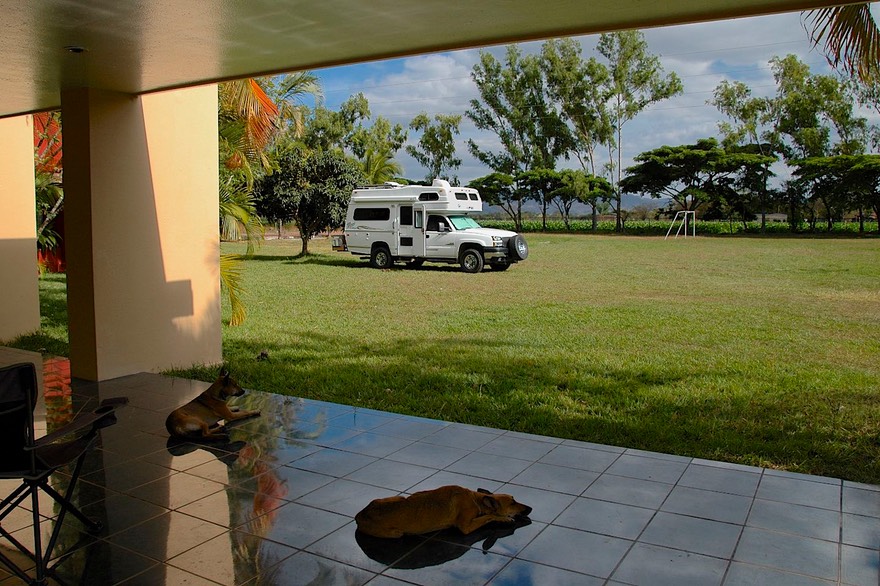
We left you as we had just crossed the border into Nicaragua. We are always excited as we enter a new country. We have great expectations of the sights to be seen, the people to be met, the fun times to be had. Nicaragua would be a really new experience for us: the poorest country in Central America; the one most recently torn apart by war; the one with the most volcanoes; a country that had suffered a devastating earthquake in 2000 and was still recovering; a country subject to serious hurricane damage from time to time; basically the most troubled country in Central America at the time of our visit - we were intrigued and inquisitive.
In the final analysis, we were a bit disappointed. And we found we were not alone when we met others traveling in the area. Despite reports from some friends who had had a fabulous time, general consensus agreed with ours. Our judgment is colored by certain events: an incident of vandalism; a cop demanding a bribe; a hot, dry and unappealing countryside; the lack of general friendliness on the road. We did have good experiences, and at least one act of major kindness where not expected. And we are well aware that we skipped some interesting areas that others had thoroughly enjoyed. But ultimately we found ourselves pushing on and hoping that Costa Rica would prove more enjoyable. But you want to know how it all went…..
Heading toward the border we noticed that the countryside was becoming very dry and brown. Cattle country, with few trees and little water. We crossed into Nicaragua from Honduras at the small town of Las Manos. Again, as with other crossings, it proved to be a good choice. Nicaragua and Honduras are friendly to each other and make it easy for the traveler. We were done in 45 minutes and on our way. We had found ourselves at the border about mid-afternoon, unusual for us, and started looking for a place to hang for the night. We headed for Ocotal, a border town, but found it to be far too quintessentially border-town-ish to be anything other than pretty ugly and rough. We did find a grocery store and a bank (gotta, in any new country), but moved on.
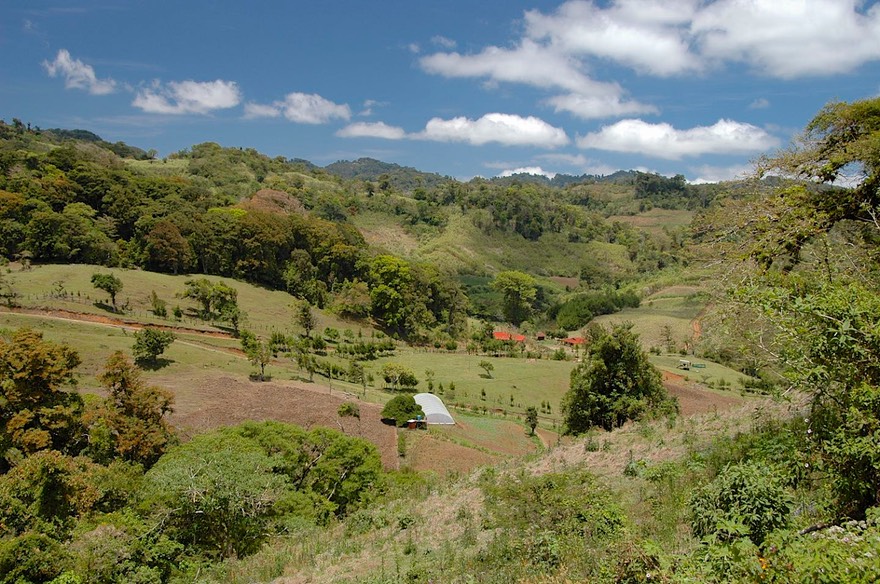
A ways into country, we reached a river and then green tobacco fields; things were looking up. We’d heard about a private club north of the town of Esteli that would let us camp; we spotted it and swung in to check it out. What a cool spot! They were happy to have us, and only asked that we give the vigilante a little money to keep an eye on us. Antonio took very good care of us, made sure we could find electricity, water, dump station, and where the dressing rooms were to change before using the pool! How about that! We found a nice grassy spot with some shade, and settled in. We were surrounded by lush, green tobacco fields; very bucolic.
Esteli has the reputation of being a good spot for language schools, and of being a nice town as well. It seemed to offer possibilities for a nice wander. We found a great produce market and bought some really yummy veggies (an oxymoron to Rick, of course); however, while we were having lunch the coach was vandalized. Not a huge deal, but someone had taken off with two of our tire pressure sensors (useless to him and $50/apiece to us – not including shipping costs) and let the air out of a third tire (couldn’t get the sensor off, we guessed, and got piqued). This made us pretty darn unhappy. Then I watched the guard outside one of the banks actually frisking folks before he would let them in (took a pair of scissors off a guy while I stood there). And there was graffiti all over the walls. (Esteli has a reputation of being very political; there are marvelous murals on the walls commemorating the struggles they had during the war. That was fine; but the graffiti was very new and very angry looking.) Well, after all this… we had been considering staying a week or so and taking some more Spanish lessons. But we just didn’t feel comfortable and decided to move on.
On the other hand, that same day in Esteli a delightful fellow spent most of an hour showing Rick various places in town that might have a rear-view mirror for us. We’d seen mirrors mounted above the rear window of many vans to allow the driver to see immediately behind the rear bumper and thought that would be a cool addition to La Tortuga. After asking at a couple of places without much success, one older fellow took us under his wing and rode with us from shop to shop until the right thing was located. He spoke good English, and some German as well, and was trying to get a job in the tourist industry. We told him to keep trying, as he would be a great asset to all of us tourists and travelers. So, as always, a really positive experience with someone served to help balance out the occasional hard times.
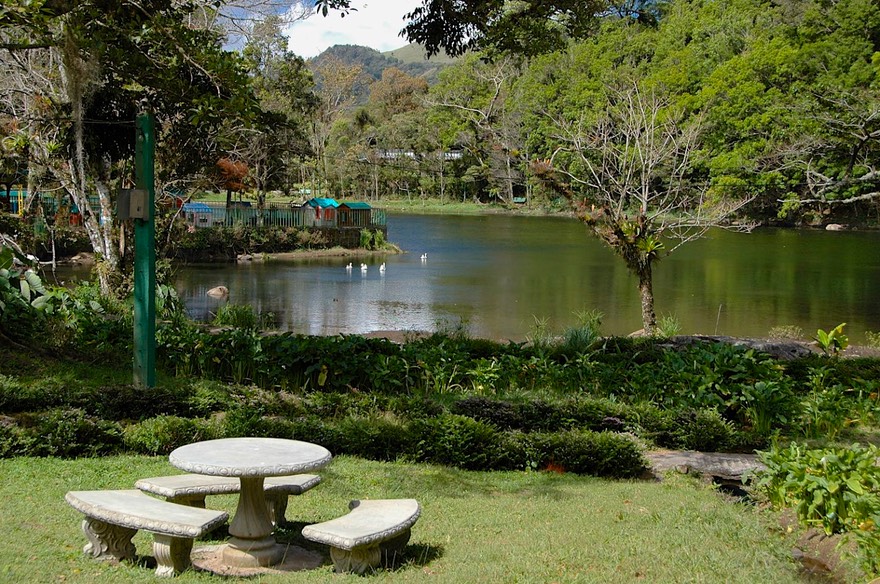
Esteli is in a large agricultural valley; leaving, we climbed over some hills and turned north, heading up into a mountainous area and the retreat known as Selva Negra. We passed many coffee fincas as we climbed. It was quite lovely, and we were on a beautiful new road. Then we hit Matagalpa and the road died. Enormous potholes, big enough to give an elephant trouble. We knew the locals were pretty unhappy as they had erected signs with pictures of cars and people falling into the huge holes. They were kinda cute, actually. We were glad we were only taking the road one time, not every day. On we went, with Selva Negra in view. Selva Negra is Spanish for black forest – like in Germany -- and is a large coffee plantation and eco-tourism destination with a world-wide reputation for sustainability. It was founded by Germans who were brought over by the Nicaraguan government in the 1880s to show them how to grow coffee, and they have thrived here. We had been told their parking lot was available to us, and that the restaurant served very good German food. We wanted to check it all out.
Selva Negra is a lovely place; they have a chapel and reception area, both of which were being prepared for a wedding about to happen. There are flowers everywhere, a large pond with a group of noisy geese, birds galore, hiking trails into the forest; all very Bavarian and charming. A great spot for a honeymoon. We had a lovely evening; I had wiener schnitzel and Rick had a very good steak dish. We took pictures of the geese, wandered the trails, and generally really enjoyed ourselves; all at a very cool and lovely 5200 foot elevation. This is a fascinating place and a highlight of anyone’s trip to Nicaragua. Well worth seeking out.
The next morning we continued on up this lumpy bumpy road, intending to visit the town of Jinotega and then take a dirt road through the mountains, ending up back at Esteli. As we climbed, we passed flower and produce stands selling the local output. The vegetables were humungous and the flowers just as spectacular. It was quite a scene, misty (still in cloud forest at this point). The scenery, too, was beautiful, but the road got worse and worse. We passed out of the forest and back into the dry-brown hills with which we were so familiar; we became less and less interested, and finally decided to retrace our steps back down the mountains rather than continuing on. That was okay with us, as we were headed for Leon (the old capital) and its pleasures. We had heard that Leon is a very interesting city, and were anxious to see it.
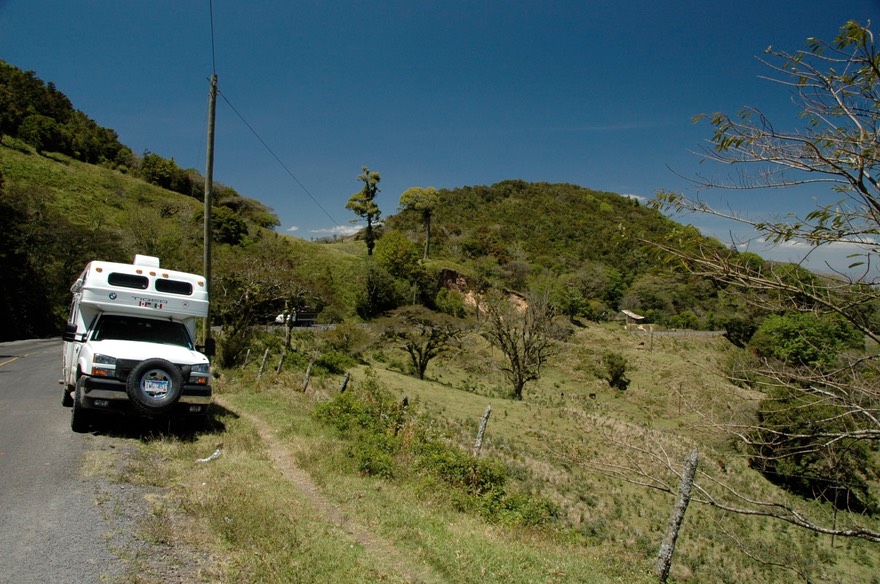
Well, dammit, Leon was going to have to survive without us. I guess it’s cumulative; REALLY bad roads – that are going to be that way for a REALLY long ways -- may just be beyond us right now. Darn it, we wanted to see Leon, but this road was the pits – BIG PITS. So, after a few miles, in sweltering heat because we were now back in the lowlands, and knowing Leon would also be very hot, we turned around. Another time, after the government starts working on these roads, we’ll come back. We know we are shooting ourselves in the foot, because we skip some places we would like to see. But we remind ourselves that we are travelers, not tourists; we see what we see, not trying to cross everything off our lists.
Back on the main highway (the Pan-American, to be exact), a good and decent road, we made our way southeast towards Masaya National Park and its nifty, active volcano. The dry brown countryside looked a whole lot like Bakersfield. Until now we hadn’t spent much time on the Pan-Am because we wander on the back roads so much. We were encountering more traffic and – got stopped by a policeman. It was a congested area; we weren’t unduly startled, as police will often pull us over and check our papers. We knew along the Pan-Am we were more likely to be faced with police irregularities. It had been suggested to us that having copies made (and laminated) of our driver’s licenses might keep us from having to pay a bribe at some point. So Rick tried it out. He handed the fellow his duplicate. The man demanded to see the original. Rick showed it to him through the window but wouldn’t give it up. The guy got really irritated and demanded $20 to give Rick back his duplicate. Rick smiled and we just drove off. We felt smug. What a jerk! There are several reasons why we tend to spend our time back in rural, out of the way places and this is one of them. The only times we’ve felt uncomfortable in any way down here have been when we’ve been on or near one of the major highways. The traffic, of course, is much worse, the police stops are much more frequent, and the border crossings are much more difficult. It’s the back roads for us, just as it is up north.
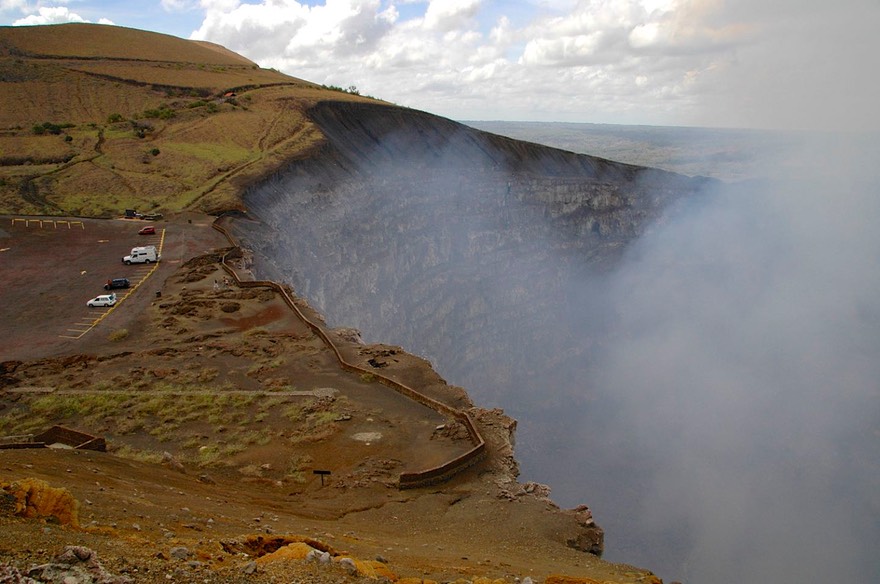
Volcanoes are cool. Vulcan Masaya is really cool. We arrived just as the park was closing, but were allowed to stay in the parqeo overnight and then drive to the top the next morning. Masaya is a collapsed volcano with an open area up at the top – misty sulphur steam coming up to meet you, strange swift-like birds, no foliage -- but huge, huge bumblebees; how weird is that! There are supposed to be parrots living there that have adapted to the fumes, but we didn’t see any. Coming back down from the volcano I saw plumeria trees in bloom. I was nonplussed, as I was used to seeing this flower in Hawaii, and then realized that the climate and terrain weren’t all that different, really. A revelation. The visitor center here is a really good one; just enough information to be helpful without so much that you are overwhelmed. Some of it was in English. They have lovely paintings on the walls showing the various kinds of birds and flowers in the area, and nice displays highlighting each of the national parks and reserves in Nicaragua. This is a really good stop to make.
After wandering the volcano and environs, we went on into the town of Masaya; a hub, it was rather chaotic and we were our usual constantly lost selves trying to find our way to the town center. But we did. This town has two market areas, and we visited both of them. We started at the “nice” artesania one, which had some very nice things; some were from Nicaragua and others from further away. They had coffee for sale, but I thought it a little pricy and hoped to find a better deal elsewhere. (We have been making it a point to buy fresh coffee in each country we visit. It has all been quite delightful, and makes a good souvenir.) Rick was looking for sandals to replace the worn ones he had bought ten years ago (can you believe that?); this is a leather goods area so we had high hopes.
Not finding the right shoes at the first market, we decided to take a taxi to the more local market across town. We had first tried to drive there, but got lost in the maze of streets and then came to a spot where we couldn’t get there from here, so went back to where we had parked before. What an eye-opener we found when we arrived at the “everyday” market. It was enormous, full of little walkways between stalls and tons of fun. And even though it was a Sunday, Rick found someone to temporarily repair his sandals while he continued his search. There were fellows sitting at old black Singer sewing machines, making and repairing shoes. While we waited, he did a good job reattaching the shoe parts that were coming loose, and said that the guy who could have put on new soles wasn’t working today, but if we could come back… all for $5.00. Probably more than we needed to pay, but we were happy to give it to him.
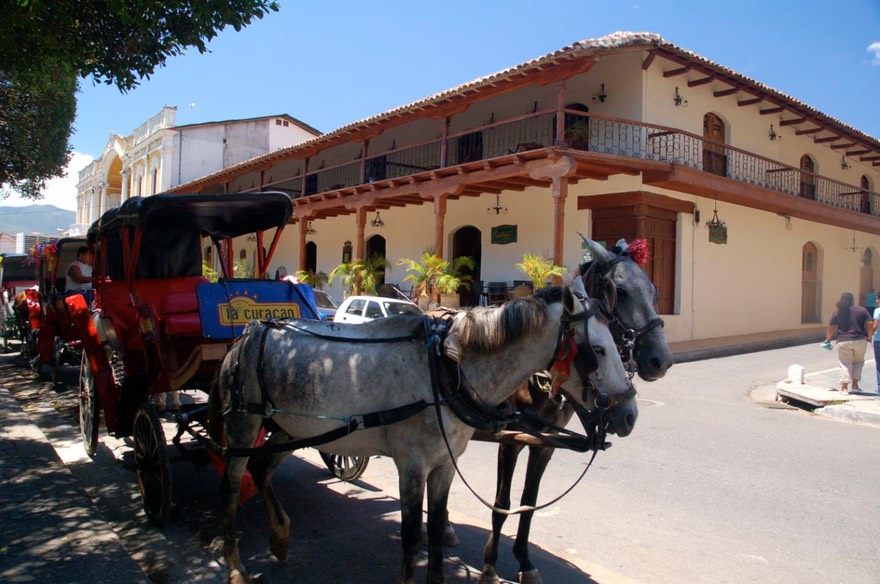
Speaking of money, we have seen, over and over, here in Nicaragua that the people are very poor. Goods are quite inexpensive; if you wanted to retire here and build a home, we suspect it would be pretty cheap. We did see some begging, although no obnoxious or pushy behavior. But there are fewer work trucks; horses are everywhere, hauling carts filled with goods, being ridden, and being used for “taxis,” pulling people around town in their carts. Mostly they look pretty tired and underfed. One guidebook mentioned that we would see lots of them in Granada, pulling carriages. The author reminded us of how hot it is during the middle of the day, how underfed the animals were, and how it might be a better choice to give the money to the driver and ask him to use it to buy feed. We also saw tons of people on bicycles, often two per vehicle. We were told that the owner of the bike was often the one sitting and being pedaled by the passenger.
Granada is quite close to Masaya, and it was our next stop. Granada is on the shores of Lake Nicaragua, and it is quite the thing for travelers like ourselves to spend the night in the tourist park along the lake. We pulled in, found a spot, and soon were joined – by a Rumanian-French couple traveling with their 3 small children. Don and Marilena were delightful; their children a joy to meet. The family was on a two-year trip in the Americas, having seen the States and Canada and now moving further south. If all went well they were considering staying out for two more years after that, traveling to Asia as well. We had a nice evening’s chat, compared notes on shipping plans for South America (they were starting to get organized and so were we), and parted company the next day. We were headed into town, and they were planning a morning of school lessons, internet, and exploring along the lake. We keep hoping to run into them again, but so far they haven’t materialized.
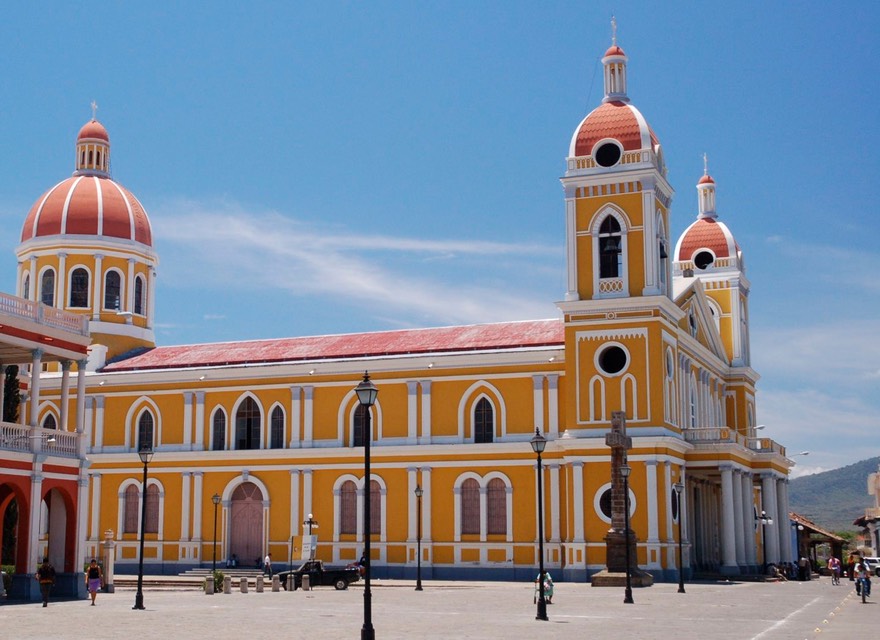
Granada is often compared to Antigua, Guatemala. It is an old colonial city with a big town square and nice buildings. We wandered around, finally found the tourist office squirreled away in a corner, and checked out some of the sights. We tried hard to like it, and indeed found it open and friendly and clean. But we’ve been to so many beautiful cities, including Antigua, and found Granada kind of ho-hum.
We were finding that in Nicaragua it was simply a poor economy. The market goods were basic, we saw less sophistication among the people, and they generally seemed more discontented and less happy than in the other countries we’ve visited.
So were we. Each place we tried seemed less than what we had expected, and we kept moving on. Suddenly we were in the southern part of the country and getting closer to the border. I called out “Slow down” and grabbed my camera. I wanted a picture at the place where the TransPacific Canal would have crossed through this area had it been built in Nicaragua instead of Panama. I’d figured out pretty closely where it should be and snapped off a couple of shots. Not a very spectacular spot, but at least I recorded it for posterity….
As we approached the Costa Rica crossing, the countryside became a little greener, with more trees; we were near water; this, to us, was the prettiest part of Nicaragua. We hit the border and chaos ensued. Our luck had run out.
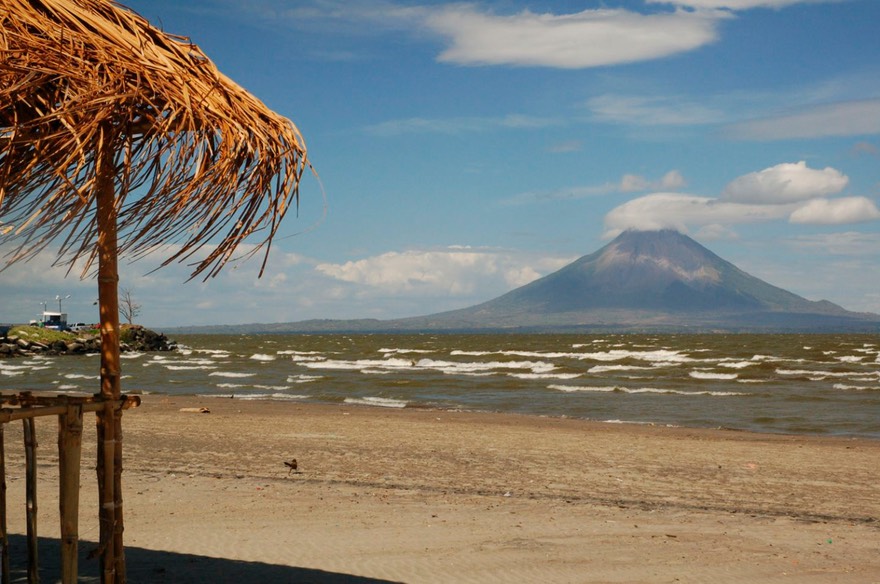
All in all, Rick says this border crossing wasn’t more difficult than any of the others; the process is the same each time. But it was filled with people insisting on helping and having their hands out for money and saying they could do this and he should go here and this is the guy and we can help make this go faster and the officials didn’t want to talk to him but were looking for “his guy” and we think they were all in cahoots and it was too expensive and we think we got rooked and all the other things we’d heard of from everyone we talked to. And it’s horribly hot and dusty and a real mess.
This is the only national border where everyone has to use the same crossing, right along the Pan American Highway. We did notice a footpath on the map that led between northern Costa Rica and Lake Nicaragua, but we sure wouldn’t have wanted to try that! Every other border crossing we have done (including into Panama, stay tuned) has been in a rural, relatively quiet area with few people and no confusion. This was Grand Central Station. But we finally made it through and limped on down the road into Costa Rica, licking our wounds. After an hour or so, we realized it really didn’t matter all that much; it’s all just fine, regardless of momentary frustrations.
Click here to see more of our pictures of Nicaragua.